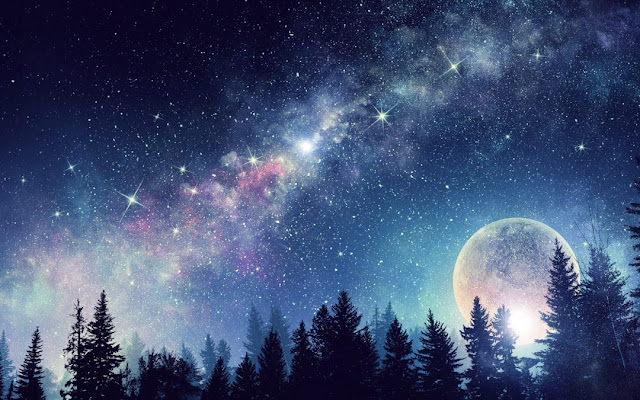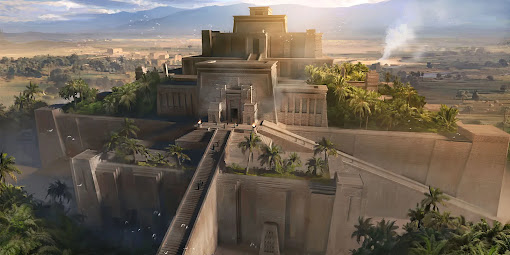Tu B'Av: Dancing in the Moonlight
From the perspective of the moon, there are two main types of Jewish festival. Some of our festivals fall when the moon is dark, and some fall when the moon is bright. Rosh HaShanah is on the first day of the month, and since our months are tethered to the waxing and waning of the moon, this means that Rosh HaShanah comes when there is the barest sliver of moon in the sky. It is not a bright night. We increase light into Yom Kippur. By the time we leave the Kol Nidrei service and walk home, we look up into the sky to see a steadily waxing moon. Likewise, Chanukah straddles the darkest time of the month, beginning of the 25th of Kislev, when the moon is waning into darkness. We light our candles into the darkest part of the month, into the darkest time of the year.
And then there are festivals which fall mid-month, when the moon is at its very brightest. The most obvious of these festivals are the beginning of Pesach and the beginning of Sukkot. They are joyous festivals indeed - and times in which we would expect to be outside at night. For Passover, in the days of the Temple, we would have been outside on the night of the 15th partaking in the paschal sacrifice. And for Sukkot, we spend our festival evening in the Sukkah, under the light of the full moon.
On the one hand: Rosh Hashanah, leading into Yom Kippur as the moon slowly regains strength; and Chanukah, which falls on the darkest time of month. On the other hand, Sukkot and Pesach, beginning when the moon is at its brightest but slowly losing light as we head into the conclusion of the festivals. Shavuot, the biblical festival clearly missing from that list, falls on the 6th of Sivan, when the moon is slowly brightening.
I’m struck by how it seems to me that the festivals which are more internally-based, the festivals in which we are interested in themes of darkness and light, of wrongdoing and teshuvah, are those which fall in the darkness. And those festivals which have a more physical element, which maybe expect us to be outside and interacting with sacrifices and with outdoor structures and nature, fall when the moon is bright. I can almost hear the Torah coming through the moonlight. On festivals like Rosh Hashanah, as we engage in repentance - and Chanukah, in which we engage with stories overcoming oppression - the moon reminds us: The light is coming. Be patient - or better, eagerly await it, because the ebbing and flowing of the light means that it is bound to return to you. And on festivals in which we are so connected to the physical world, to paschal sacrifices and seder plates filled with edible symbols, and to our sukkot outside with their tentative roofs - or also on Tu Bishvat, the festival of the trees in which we hold a seder over fruits - there, we hear a different message. Behold! Here is the light; here is your ability to see the wonder of creation; please take a moment and revel in it.
I don’t only mean to wax poetic about the moon. (That was bad.) I’m thinking about the moon today because we are, indeed, in the mid-month. Today is the fifteenth day of the month of Av. And being the 15th day of the month of Av means that today is a special day: Tu b’Av. Today is, in fact, a Jewish festival. It also has a physical, creation-based, agricultural context. Tu b’Av marks the beginning of the grape harvest - and it’s known to be a particularly joyous holiday. There is, of course, a link between grapes and joy in our great tradition - we say special b’rakhot over wine and grapejuice in the most joyous of our celebrations, like the brit milah, the wedding, Shabbat, and festivals.
But more than simply being a joyous celebration at the beginning of a harvest, Tu b’Av is also known as ḥag ha-ahavah, the festival of love. According to the Mishnah (Taanit 4:8), Tu b’Av was a day in which the maidens of Israel would dress in white and dance in the vineyards, and the young men were encouraged to find wives from among them. It’s a romantic scene already, and perhaps all the more so when imagined in the light of a full moon. But Tu b’Av is not simply Jewish Valentine’s Day, it is a date linked with multiple stories of people coming together, of unification and reunification. Tu b’Av was the day in which the Tribe of Benjamin reentered the community after a period of significant turmoil in the Book of Judges. It is the day that the gates between the Northern and Southern kingdoms of Israel and Judah were opened again after 200 years of the nation being kept apart. Tu b’Av is about finding our place with one another.
I think there are two great lessons for us in this Tu b’Av: the importance of being outside, and the importance of being together. Tu b’Av is a festival of great moonlight. It is one of the festivals in which we are encouraged to experience creation in the light of a full moon, in which we leave our firm walls behind, in which we allow ourselves to be untethered and unbound by human creation and instead exist in the raw creation of God. We know the importance of being outside. We know that now perhaps better than we ever have. May we never take it for granted again.
And Tu b’Av is a festival of togetherness. For the maidens dressed in white, it was about romance and marriage; for the tribe of Benjamin, it was about reconciliation; for the Northern and Southern kingdoms, it was about walking past walls and being together again. Need I say more? There have been so many boundaries between us recently. Some of those have been walls like that between the Northern and Southern kingdoms - and thank God those doors are now open and we are able to be physically together once again. Some of those boundaries have been emotional, and like Benjamin, we are now gifted with the ability to look into one another’s faces as we reconnect. And some of those boundaries haven’t been about being far away, but rather about being so close together that we trip over one another, or treat one another like furniture instead of partners and family. But Tu b’Av is a time for moving past those boundaries and being together. I encourage us all to locate those walls and begin to move beyond them - to spend time together, to say ‘sorry’ for the breakdowns that a crisis like this has no doubt encouraged, to say ‘I love you’ to people we might have taken for granted.
Today is a beautiful and oft-overlooked festival, but this year it seems to be calling more strongly to me than ever before. I hope that we can listen to the call for celebration, and reconciliation, and togetherness. May we find many reasons to be joyous together. (To Charlie, our Bar Mitzvah, I would like to say thank you for giving us a reason to do that today.) And to us all, I would like to say: ḥag ahavah sameach - may it be a joyous festival of love.



Comments
Post a Comment